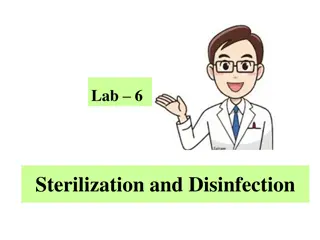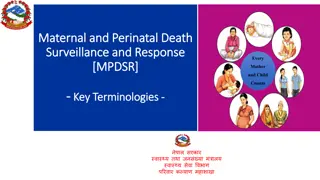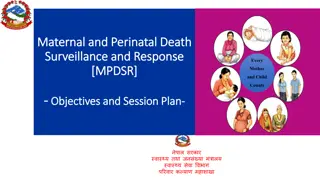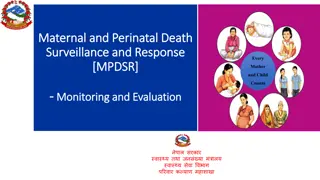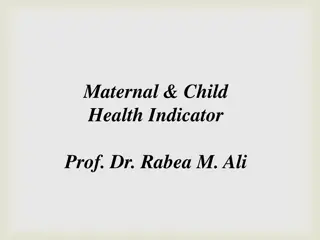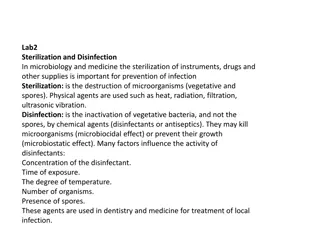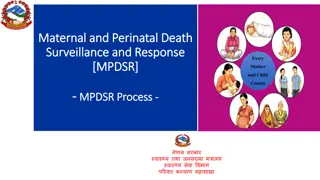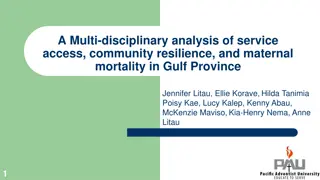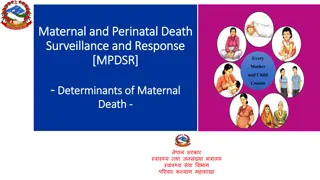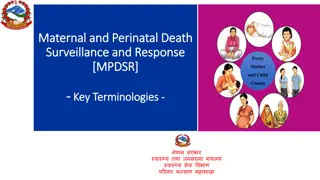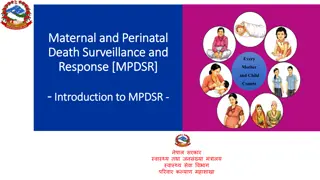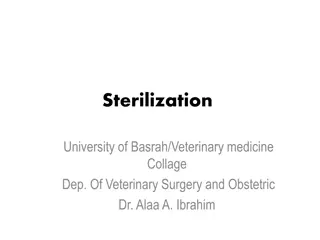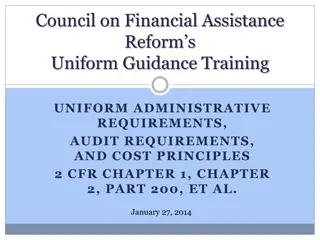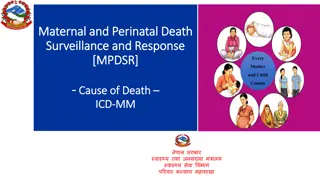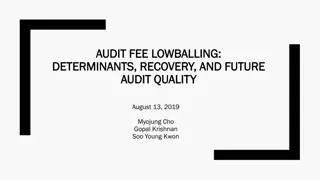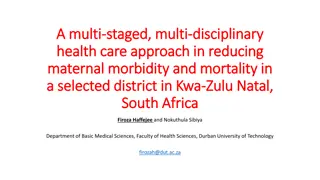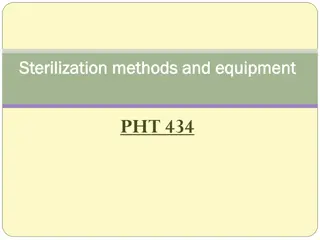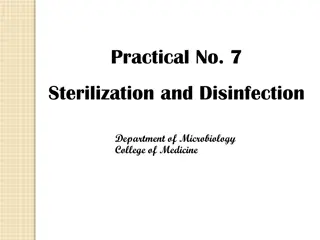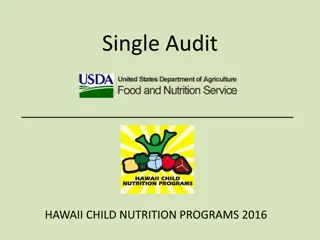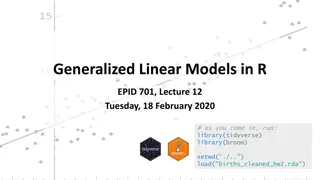Reduction in Deaths following Sterilization & Maternal Death Audit - Tamilnadu Experience
Tamilnadu has successfully achieved replacement levels of fertility and focuses on promoting maternal health through various contraceptive practices. The state conducts audits to identify causes of sterilization deaths, with a major emphasis on improving maternal health care to reduce mortality rates. The analysis shows a decline in sterilization deaths over the years and highlights the importance of addressing pregnancy-related complications. The maternal death rate in Tamil Nadu showcases a downward trend, indicating ongoing efforts towards improving maternal health outcomes.
Download Presentation

Please find below an Image/Link to download the presentation.
The content on the website is provided AS IS for your information and personal use only. It may not be sold, licensed, or shared on other websites without obtaining consent from the author. Download presentation by click this link. If you encounter any issues during the download, it is possible that the publisher has removed the file from their server.
E N D
Presentation Transcript
Reduction in Deaths following Sterilization & Maternal Death Audit- Tamilnadu Experience MD NHM TN
Tamilnadu achieved replacement levels of fertility in 1990 s and now we have a TFR of 1.7. Every year Tamil Nadu has a birth cohort of approximately 10 lakh live births which comprises of 8% higher order births (HOB). This cohort needs a basket of choice in contraceptive practices to promote maternal health by various methods like IUCD, PPIUCD, Puerperal Sterilisation, interval sterilisation, Laparoscopic sterilisation etc. appropriately. The maternal and child health outcomes are closely linked to spacing, which is fundamental to healthy pregnancy outcomes.
COMPOSITION OF VARIOUS METHODS OF STERILISATION 2016-17 Performance 2016-17 S.No Name of method % 387040 (140595- PPIUCD) 1 IUCD 47.8 2 Permanent methods 272907 33.7 3 Condom users 91785 11.3 4 OCP users 57608 7.1 Grand Total 809340 100
COMPOSITION OF VARIOUS PERMANENT STERILISATION METHODS IN TAMIL NADU 2016-17 S.No Type of Method Performance of Method wise sterilisation % of coverage in Total sterilisation Puerperal sterilisation (PS) 1 217243 79.6 Laproscopic Sterilisation 2 29052 10.6 TAT/Mini lap 3 25869 9.5 Vasectomy 4 736 0.3 Grand Total 272907 100
Year-Wise Analysis of Sterilisation Deaths Number of Sterilisation Deaths Deaths per One lakh Sterilisation Number of Sterilisation Year 2012-13 316990 34 10.7 2013-14 323310 29 9.0 2014-15 311322 22 7.0 2015-16 289432 10 3.5 2016-17 272907 9 3.3
Auditing of sterilisation death and identifying the real cause of death Proper audit mechanism by district and state quality assurance committee of these deaths revealed major underlying causes to be related to pregnancy not sterilisation. Pregnancy related complication was the major factor and the state and District quality assurance committee was able to identify the real issues. With 80% of sterilisation with in 7 days of delivery the improvement had to be in maternal health care . Any intervention to reduce deaths needed to have a strong maternal health component
Over View of Maternal Death - Tamil Nadu MMR/100000 LB S.No Year Live Birth Death 1 2015-16 637 67.78 937042 2 2016-17 904957 583 64.31
Maternal Mortality Ratio TAMIL NADU 350 300 301 250 254 212 200 178 167 150 134 111 100 97 90 79 71 69 67 64 50 0 2001-03 2004-06 2007-09 2010-12 2011-13 2013-14 2014-15 2015-16 2016-17 India Tamil Nadu Source: SRS (2001-03 to 2011-13) State HMIS (2013-14 to 2016-17)
Cause Wise Analysis (Apr'15-Mar'16) (Apr'16-Mar'17) Respiratory 2% Hepatic 3% Hepatic 3% Anemia 3% TB Others 5% complicating 2% Others 5% Respiratory 4% Cardiac arrest / Multiorgan failure / Shock / Pulmonary edema 5% Hypertensive disorders in pregnancy* 21% Hypertensive disorders in pregnancy* 23% CVA /CVT 5% Anemia 3% CVA /CVT 7% Heart Disease 9% Haemorrhag e 17% Sepsis 8% Haemorrhage 21% Cardiac arrest / Multiorgan failure / Shock / Pulmonary edema 11% Sepsis 10% Embolism 10% Embolism 12% Heart Disease 11%
Maternal Death Due to Heart Disease Vs Gravida 20 19 19 18 16 14 12 10 8 8 7 6 4 2 2 1 0 Primi G2 G3 G4 G5 G6 Inference : Even a heart disease mother goes for repeated pregnancies which ultimately leads to the death of the mother
Interventions Planned Based on Cause Wise Analysis S.N Problem statement Interventions Vision 10% of total maternal deaths is contributed by heart disease complicating mothers Reintroduction of inj.Penicillin for Rheumatic heart disease identified children through RBSK up to 18 years PPIUCD / interval IUCD / permanent sterilization to be followed Inj.Penicillin should be made available from CHCs for Rheumatic heart disease identified children through RBSK up to 18 years once in three weeks. Special card to be maintained for regular follow up 1
Gravida Wise Maternal Deaths (Apr'15-Mar'16) (Apr'16-Mar'17) 300 250 228 272 250 200 189 216 200 150 150 95 100 100 87 45 50 41 50 15 13 6 5 2 2 2 2 1 0 0 Primi G2 G3 G4 G5 G6 G7 G9 Primi G2 G3 G4 G5 G6 G7 G8 G9 8% of High Order Birth Contributes to 30% of Total Maternal Deaths 72000 high order birth out of 9 lakhs contributes to 166 maternal deaths (2016-17)
Special strategies to tackle key issues contributing to Maternal Death based on the above analysis Problem statement Name of the Activity Special strategy 8% of HOB contributes to 30% of Maternal deaths 120 HOB block strategy. Out of 385 blocks these 120 blocks who had high HOB % were selected for specific interventions. Specific strategies like , interval IUCD promotion, PPIUCD. Each of these blocks have a special strategy for HOB reduction based on its specific issues. As we have 99.5% institutional deliveries the institutions provide contraceptive choices to mothers.
> 30 years Maternal Deaths (Apr'15-Mar'16) (Apr'16-Mar'17) Anemia 3% Others 12% Renal 3% Others 4% CVA /CVT 7% Hypertensive disorders in pregnancy* 18% Respiratory 7% Hypertensive disorders in pregnancy* 24% Respiratory 4% Anemia 5% Cardiac arrest / Multiorgan failure / Shock / Pulmonary edema 9% Haemorrhage 16% CVA /CVT 6% Haemorrhage 16% Sepsis 8% Embolism 9% Sepsis 14% Embolism 9% Heart Disease 13% Heart Disease 13% 5% of total deliveries of mothers more than 30 years contribute to 19% of maternal deaths- Automatic high risk
Period of Death & Type of Delivery Wise (Apr'15-Mar'16) (Apr'16-Mar'17) 600 500 447 450 486 500 400 350 400 300 247 300 250 267 200 221 200 200 130 150 141 100 100 50 11 6 0 0 AN IN PN Normal PostNatal LSCS AN IN PN Normal PostNatal LSCS Twin Pregnancy (I-Normal, II-LSCS) Out of total maternal deaths, 23% is in the antenatal period (2016-17)
Antenatal Cause of Death (Apr'15-Mar'16) (Apr'16-Mar'17) Others 13% Ectopic 4% Anemia 3% Others 8% CVA /CVT 4% Obstructed Labour 3% Hypertensive disorders in pregnancy* 20% Heart Disease 19% Anemia 4% Abortion 3% Embolism 5% Cardiac arrest / Multiorgan failure / Shock / Pulmonary edema 6% Hypertensive disorders in pregnancy* 18% Haemorrhage 7% Heart Disease 18% Haemorrhage 7% Cardiac arrest / Multiorgan failure / Shock / Pulmonary edema 8% Embolism 8% CVA /CVT 8% Sepsis 11% Sepsis 15% Respiratory 8% Others: 19 Ectopic-2, Renal-3, Respiratory-4, Hepatic-3, Chronic conditions-2, GDM-3, Obstructed Labour-4 Other causes:11 Tb Complicating-2, Hepatic-4, Chronic conditions-1, Abortion-1, Obstructed Labour-2, Renal-1
Interventions Planned Based on Cause Wise Analysis S.N Problem statement Interventions Vision Out of total maternal deaths 23% is attributed to antenatal deaths in which 15% is contributed by sepsis which indirectly means that abortion deaths of unwanted pregnancies by over the counter abortifacient drug sale and incomplete abortion. 1.Promotion of PPIUCD up to PHC level 2.Provision of MVA services up to CHC level involving PHC doctors 3.Provision of MMA drugs up to CHC level 4.Door step delivery of contraceptives through ASHAs 5.Strong legal action against untrained quacks Strict monitoring and supervision for implementation of the above activities in the field level by JDHS and DDHS. 1
State MCTS Apr16-Mar'17 100 86.6 90 80 70 60 50 40 30 20 13.4 10 0 Booked Mothers Unbooked Mothers To capture the unbooked mothers in State MCTS portal revamped MCTS portal is in trail run in three pilot blocks
Improvements in Newer MCTS Portal S.N o Old MCTS Portal New MCTS Portal Separate for State MCTS & Muthulaksmi Ready Maternity Benefit Scheme State MCTS & Muthulaksmi Ready Maternity Benefit Scheme in one software 1 Developed in hybrid environment (works in a computer, mobile or tablet) 2 Not hybrid environment Pre registration through CSC/102/Self/Govt institutions 3 No pre-regstration No unique Id. For every pregnancy separate ID is created 4 Unique RCH ID which is valid through out India EC registration & tracking (only after EC (eligible couple) registered we can enter ANC data) 5 Entry captures from ANC level only 6 No Aadhaar authentication Aadhaar authentication
Improvements in Newer MCTS Portal S.N o Old MCTS Portal New MCTS Portal No provision for institution to enter delivery 7 Provision for Govt. institution to enter delivery Visitor registration compulsory (mother service can be maintained and can be transferred any time from one place to other) 8 Visitor registration not compulsory SMS to VHN, mothers, MO, BMO, District and state level officers. 9 No SMS support No birth certificate uploading provision 10 Uploading birth certificate (until effective CRS linkage) CRS linkage. This will ensure that all private deliveries will also be entered in the MCTS portal 11 No CRS linkage Server space along with few other Govt. sites Separate server space (additional cloud space will be obtained whenever required) 12
To Ensure all High Risk Mothers (HOB, Migrant, Private Maternity Care Mothers) are booked Proposed Conditionalities for Fund Transfer in MRMBS Scheme Rs. 18000 Per Mother S.No Name of the instalment with amount Old MRMBS New MRMBS Promotes early registration before 12 weeks of pregnancy including migrant mothers. Unique RCH ID is obtained. Aadhaar authentication should be done before release of 1st instalment. Early detection of ectopic pregnancy if any, hyperemesis gravidarum can be treated effectively Diet care to under weight mothers can be given. Immunization against tetanus can be availed when visited earlier and neonatal tetanus can be overcome. First Instalment (Rs. 2,000) 1 -
To Ensure all High Risk Mothers (HOB, Migrant, Private Maternity Care Mothers) are booked proposed Conditionalities for Fund Transfer in MRMBS Scheme S.No Name of the instalment with amount Old MRMBS New MRMBS Given at the time of 4th month of pregnancy for the beneficiaries satisfying the below conditions. The beneficiary should have availed services like TT immunization, Hb testing, minimum one USG, GCT and BP evaluation. Early detection of fetal anomalies and neural tube defects can be diagnosed and treated Screening for Anemia, GDM, and PIH done effectively Second Instalment (Rs.4,000) 2 Same as old MRMBS
To Ensure all High Risk Mothers (HOB, Migrant, Private Maternity Care Mothers) are booked proposed Conditionalities for Fund Transfer in MRMBS Scheme Rs. 18000 Per Mother. S.No Name of the instalment with amount Old MRMBS New MRMBS In addition, Primi should have PPIUCD inserted and for second delivery mother should have either PPIUCD inserted or under gone permanent sterilization. Ensures all mothers get family planning services and adequate spacing between the deliveries This spacing/permanent sterilization will help the mother to regain her health Mothers delivered in Government / Local Body Institutions and approved private medical college hospitals where free delivery services are provided. Eligible only for first two deliveries Third Instalment (Rs. 4000) 3 The fourth instalment of cash assistance will be given to Mothers, who received 3rd instalment and after completion of 3rd dose of OPV & Pentavalent immunization to their Infants. Ensures the infant is immunized at the right time and prevents the spread of deadly diseases Fourth Instalment (Rs. 4,000) Same as old MRMBS 4
To Ensure all High Risk Mothers (HOB, Migrant, Private Maternity Care Mothers) are booked proposed Conditionalities for Fund Transfer in MRMBS Scheme S.No Name of the instalment with amount Old MRMBS New MRMBS The mothers who received fourth instalment are eligible to receive fifth instalment after completion of MR vaccination. HOB mothers who received first instalment are eligible to receive fifth instalment after completion of MR vaccination Ensures that the infant is fully immunized Prevents HOB deaths by nudging mothers to have a choice of contraception. Fifth Instalment - (Rs. 4000) 5 -


